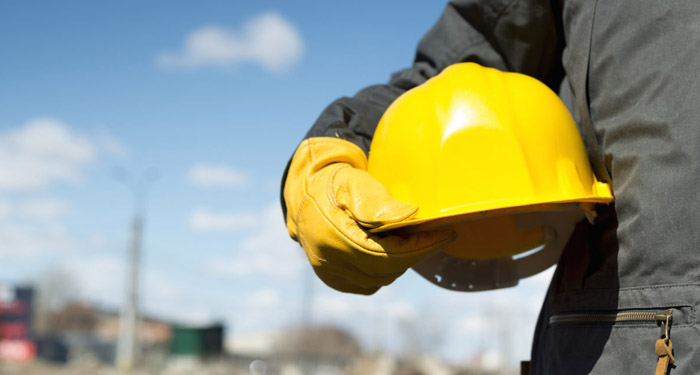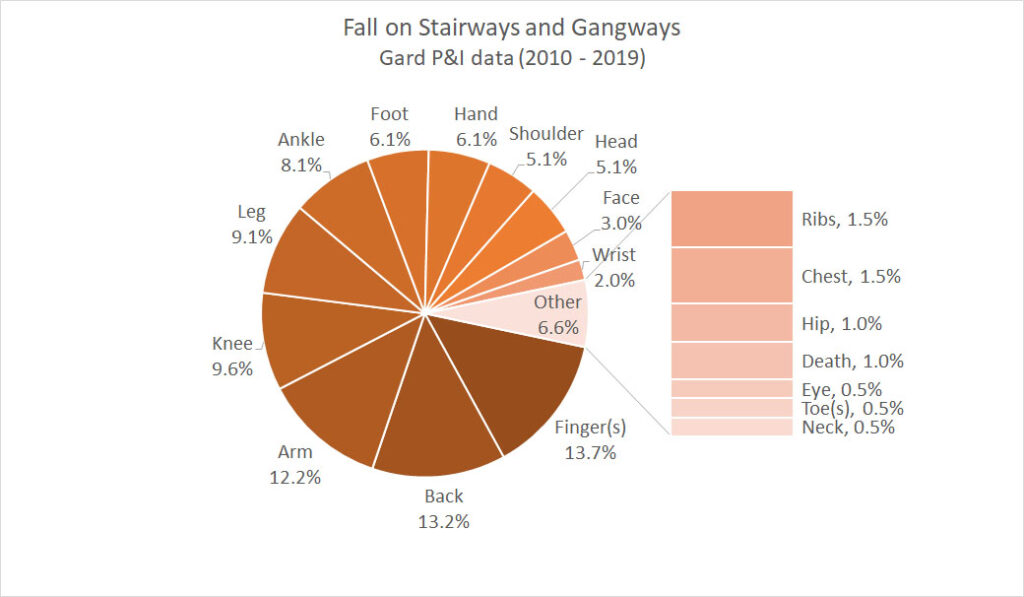Gard warns about the dangers of walking up or down stairs at ships. As it says, seafarers should always apply the old adage of ‘one hand for yourself and one for the ship’ and keep one hand free to grasp the handrail.
According to the UK Health and Safety Executive (HSE UK), the highest chance of a person falling in a staircase is during the swing phase of the trailing leg. The injuries sustained by a person when walking down the stairs are more serious compared to a fall occurring when walking up a set of stairs. The injuries can vary from bruises, sprains, bone fractures to death in more serious cases.
As Gard claims, fingers, backs, arms, knees and legs are the most common body parts injured due to falls in stairways and on gangways.
Causes for slips and falls on stairs
The stairways on ships are usually at a steeper angle than stairs ashore and the ship’s motion in the sea creates additional challenges.
Very often crew ascend and descend the stairs without holding the handrails, usually because both their hands are occupied in carrying tools or other objects.
There may be other contributory causes, such as stairs may be slippery, proper footwear was not worn, anti skid tape not applied or the crew member is in a hurry.
Not holding a handrail greatly increases the risk of the person sustaining an injury from the fall
Addressing the risk of injuries from falls on stairs
Firtly, crew must be trained to always keep one hand free to grasp the handrail if needed. Instead of carrying tools in the hand, where possible tools should either be carried in a belt or some other way be found to move them. They can use the trailing hand technique when walking down.
Trail the strongest of the two hands underneath the handrail behind yourself and turning the body slightly towards this hand when walking down. If the person falls, the trailing handgrip can prevent a serious injury.
Furthemore, stairways, handrails and landing surfaces onboard should be properly maintained and kept clean and free from substances liable to cause a person to slip or fall. More specifically, during the safety rounds, crew should check that the stairs:
- Have slip resistant properties, especially at the leading edge
- The edges and the landing areas are clearly marked
- Are free from obstacles or other hazards
- Are well lit.
Lifting, slips, and falls incidents the most frequent at sea
ABS, the American Club, and Lamar University (Lamar) are calling on industry to promote the cause of safety at sea with more comprehensive reporting requirements for injury and near miss reporting. This call comes after an industry-wide project analyzing more than 12,000 injury records.
Falls account for 22% of the incidents in the American Club data set, slips for 12%, and fall events were more expensive than slip events in the American Club data set. Falls were also common in the ABS/Lamar data set accounting for 23% injuries. Slips and trips were also common in injury in the ABS/Lamar data set (6% of records).
In addition, falls were more common than slips and trips in both data sets, due to slip events not resulting in reportable injuries. This is commonly called a near miss or close call. Based on the ABS/Lamar data set, common locations for falls that caused injury are deck (43%), engine room (13%), and stairs (7%). Common locations for slips that caused injury were deck (44%), stairs and ladders (13%) and engine room (11%).
From the ABS/Lamar MSRI data set, injuries involving slips, trips, and falls accounted for 11% of the records, while near misses accounted for more than 24% of records. However, situational awareness, spills, poor housekeeping, and inappropriate lighting, also contributed to injury records. Other key contributing factors related to the near misses include situational awareness, housekeeping, asset design, seafarer fatigue, lack of following procedures, and lack of anti-skid material on decks.



Comments
Post a Comment